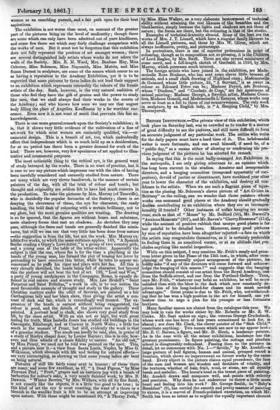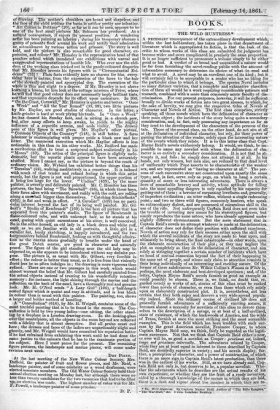BRITISH INsTrrunow.—The private view of this exhibition, which took place
on Saturday last, was so crowded as to render it a matter of great difficulty to see the pictures, and still more difficult to form an accurate judgment of any particular work. The critics who write for the daily papers must have a hard time of it. The hebdomadal writer is more fortunate, and can avail himself, if need be, of a "public day," as a means either of altering or confirming his pre- vious judgment of the pictures he has selected for remark.
In saying that this is the most badly-managed Art Exhibition in the metropolis, I am only giving utterance to an opinion which has long been current in the studios. Amateur and irresponsible directors, and a hanging committee (composed apparently of car- penters), devoid of justice or discernment, have combined year after year to lower the character of the exhibition, and destroy all con- fidence in the artists. When we see such a *rant piece of injus- tice as the placing Mr. Solomon's clever picture of "Art Critics in Brittany" on the ceiling, can we wonder that those painters whose works can command good places at the Academy should gradually decline contributing to an exhibition where they are so incompre- hensibly ill treated? Other instances of unfair hanging are nume- rous, such as that of "Moses" by Mr. Bedford (50), Mr. Barwell's "Anxious Moments" (307), and Mr. Raven's "Cherry Blossoms" (514), while the amount of positive rubbish that usurps good places is far too painful to be detailed here. Moreover, many good pictures by Men of reputation have been altogether rejected—a fate on which the artists may congratulate themselves, as it is certainly preferable to finding them in an unnoticed corner, or at an altitude that pre- cludes anything like careful inspection.
While on this subject, I may mention Mr. Frith's manly and gene- rous letter given in the Times of the 13th inst., in which, after COM- plaining of the generally unjust arrangement of the pictures, he boldly asks "if any of the directors will come forward and acknow- ledge the hanging of this season ?" and suggests that the hanging committee should consist of one artist from the Royal Academy, one from the Suffolk-street, and one from the Portland Gallery. Then, says Mr. Frith, "whatever may befal an exhibitor, he will be more satisfied than with the blow in the dark which now constantly de- prives him of his long-looked-for chance and its much needed advantages." Great praise is due to Mr. Frith, who, notwithstand- ing that he has won a high position in the art for himself, can yet bestow time to urge a plea for his younger or less fortunate brethren.
Many familiar names are absent from the catalogue this year. We may look in vain for works either by Mr. Roberts or Mr. E. W. Cooke. Mr. Sant makes no sign ; the veteran George Cruikshank, whose work one has been of late years accustomed to look for, is absent ; nor does Mr. Clark, the clever painter of the "Sick Child," contribute anything. Two names which are new to me appear here : Mr. E. C. Barnes, a figure, and Mr. D. Birch, a landscape painter. As is the case with all the minor exhibitions, landscape has the greatest prominence. In figure painting, the cottage and pinafore school is disagreeably redundant. Passing then to the pictures in detail, let us commence with No. 1—" Seville," by Mr. Ausdell—a large picture of half figures, human and animal, grouped round a fountain, which shows no improvement on former works by the same hand. Every object in the picture claims equal precedence, the face of the man and woman are wooden and destitute of vitality, and the textures, whether of hair, fruit, wool, or stone, are all equally harsh and metallic. The horse's head is the truest piece of painting. Mr. Ansdell draws and composes well, and paints with celerity and precision. Why does he not endeavour to throw a little more heart and feeling into his work? Mr. George Smith, in "Baby's Breakfast" (9), has carried the smooth and pretty manner of painting to excess, it is a marvel of French-polished execution, on which Mr. of -drawin,r,. The mother's shoulders are broad and shapeless, and the face of the child holdiwi. the basin is neither pretty nor mfantine. "Art Critics in Brittany" (20), as far as it can be seen, appears to be one of the best small pictures Mr. Solomon has produced. As a natural consequence, it enjoys its present position. A wandering artist has been painting an interior ; during his temporary absence a group of peasants flock around his work and testify their admiration or. astonishment by various action and grimace. The story is well told, and the picture is also remarkable for good character, ex- pression, and coIonr.4 Mr. Hemsley is the representative head of that pinafore school which inundated our exhibitions with unreal and exaggerated representations of humble life. Who ever saw the chil- dren of the working class tricked out in the gaudv-eoloured draperies that Mr. Hemsley invests his figures with in "Circumstantial Evi- dence" (33) ? Plain facts evidently have no charms for him, every- thing here is untrue, from the expression of the faces to the hair orthe slovenly-painted and apocryphal dog. The execution of the whole is thin and slight to a degree. If Mr. Hemsley is not above learning a lesson, let him look at the cottage interiors of Frere, where he:will find that good colour does not necessarily imply brilliant tints, nor that expression depends for its effect upon caricature. In 300, " ()n the Coast, Cornwall," Mr.Ilemsley is quieter and better. "Once a Week" and "All the Year- ortncl" (38, 39), two little pictures by Mr. Hayllar, are good studies of character. In the latter, a knife-grinder is hard at work -plying his trade. In "Once a Week" he. has donned his Sunday best, and is sitting in a church pew, but after many efforts to keep awake, he yields to the mighty influence of a soporific sermon, and nods visibly. The drowsy pose of this figure is well given. Mr. Hayllar's other picture, "Common Objects of the Country" (148), is still better. A farm labourer is contemplating with proper pride a black sow and her litter. The mannered execution which Mr. Hayllar affects is less noticeable in this than in his other works. Mr. Bedford has made a meritorious effort to treat a scriptural subject realistically in his "Moses" (50). The action of the principal figure is slightly melo- dramatic, but the aquatic plants appear to have been accurately stildied. More I cannot say, as the picture is beyond the reach of ordinary vision. Mr. Wyburd has rthibited better things than his "Teresina" (52), walking meditatively in a cemetery. It is imbued with much of that tender and refined feeling in which this artist excels, but the figure is not well proportioned, the upper portion of it 'being too large for the lower. "Undine" (439),. by the same painter, is sweetly and delicately painted. Mr. C. Rossiter has three pietures, the best being "The Snowball" (56), in which three boys, their faces alive with merriment, and ruddy with the cold, are rolling along a snowball bigger than themselves. "Catching Stickleroacks" (502) is flat and weak in effect. "A Cavalier" (589) has no parti- cular' interest beyond the fact of its being well painted. Mr. Gil- beres "Studio of Rembrandt" (169) is the best oil picture that has appeared from this painter's studio. The figure of Rembrandt in flame-coloured robe, and with unkempt hair, as he stands at his easel, gazing with quiet earnestness at his sitter, is well conceived. So is the sitter herself, an old lady in a black dress and white ruff, such as we are familiar with in old portraits. A little girl in a cavalier hat, busily sketching, is happily introduced, and the two burgomasters behind Rembrandt, looking on with thoughtful admira- tion as the canvas seems gradually to breathe under the hand of the great Dutch master, are good in character and naturally posed. The figure of the girl standing near the old lady may be objected to, as she appears to be introduced without any definite pur- pose. The picture is, as usual with Mr. Gilbert, very forcible in effect; the colour is better than usual, as it is free from that violently florid hue he so pften indulges in ; the drawing is more vigorous than refined. There are one or two passages in this work which would almost warrant the belief that Mr. Gilbert had carefully painted from the actual objects instead of trusting to his wonderfully retentive memory : for instance, the light shining through the canvas and the reflection on the back of the easel, have a thoroughly real and genuine look. Mr. H. O'Neil sends "A Lazy Girl" (196), a-lialf-length seated figure which is quaint and easy in attitude, and is less black in colour than is usual with this painter. The painting, too, shows a larger and bolder method of handling.
A "Consultation" (616), by Mr. H. Weigall, contains some of the most truthful painting that is to be found in the rooms. The Con- sultation is held by two young ladies—one sitting, the other stand- ing. by a fireplace in a London drawing-room. In the looking-glass over the mantelpiece, all the objects in the room beyond are reflected with a fidelity that is almost deceptive. But all praise must end here ; the dresses and faces of the ladies are unpardonably slight and hostly, and Mr. Weigall would have consulted his reputation better if he had refrained from exhibiting this work until he had done the same justice to the animate that he has to the inanimate portion of his subject. Here I must pause for the present. The remaining figure pictures, the landscapes and marine pieces, will come under revision next week.
DRY POINT.
At the last meeting of the New Water Colour Society Mrs. 3)uffield, the painter of fruit and flower pieces, and Mr. Reid, a landscape painter, and of some celebrity as a wood draftsman, were elected associate members. The Old Water Colour Society held their annual election meeting on Monday last, but although there were no less than twenty candidates for the two vacancies that had to be filled up, no election was made. The highest number of votes was for Mr. F. Powell, a landscape painter of some promise.
D. P.































 Previous page
Previous page